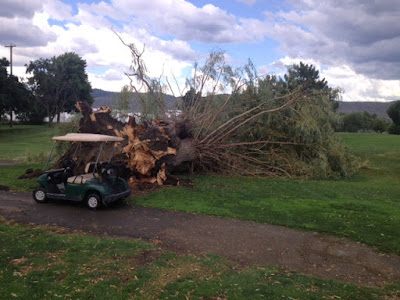This week the golf course is enjoying a
much needed break from the dog days of summer. The cooler weather gives our
maintenance team the opportunity to undertake a few different cultural
activities including: verticutting and topdressing greens, aerating and
fertilizing disease/dry spots on fairways and tees, as well as overseeding what
remains of the weak areas.
 |
| Willow Tree on the 1st hole. |
 |
| Baby birds, nesting in the willow trunk |
Over the last month we have had quite a bit
to deal with. At the end of June we had a damaging windstorm which downed many
large tree limbs on the course, as well as completely knocking over the old
willow on the right side of the 1st green. We had to bring in an arborist
to remove the fallen tree while we dealt with the damage to the rest of the
course. Upon removing the trunk of the willow the arborist discovered a number
of surviving bird nests. We decided to wait until the birds are old enough to
fly away from the nest before continuing with the rest of the removal.
We are still having problems with
irrigation water quality; debris in the water clogs the filters in the
sprinkler heads, causing them to underperform. The result is dry areas that become
weak and susceptible to disease. Currently many of these areas are infected
with a disease called anthracnose.
The good news is that bentgrass is very
resistant to this disease; the bad news, poa annua is not. Most of our fairways
are poa, and fairways are a very large area. To do a blanket application of fungicide
to completely control the disease is in the neighborhood of $12,000. Obviously this is not in the realm of budget, so to do spot applications we are looking between $2000-3,000;
however, thankfully, the cool weather reduces the severity of the disease,
giving us the opportunity to try and bring these areas back to health with
fertilizer. Healthy turf resists disease, so if we can get these areas healthy without the use of fungicides, we can save a lot of money. Last week we
purchased $150 of an agricultural grade of Urea fertilizer. We melted this down
and added it to water to be sprayed directly on these areas. The benefit of
this is that it supplies instant nitrogen to the turf. Hopefully we will see
these areas recovering this week, but if we continue to see the anthracnose
spreading, we will have to consider purchasing fungicide for spot applications.
 |
| Anthracnose, 1st fairway. |
 |
| Clogged sprinkler head, dry spot, 4th tee |
As I mentioned, the underlying issue here
is the effluent water. If our sprinkler heads were working properly the turf
would be healthy and we wouldn’t have a disease issue. Last week Sam and I
spent about 30 hours combined unclogging sprinkler heads, only to have ones we
fixed at the beginning of the week clogged again. Very frustrating. I am
looking into the costs of different filters and screens we can put right on our
effluent mainline. So far the cheapest option is a “basket strainer” which is a
cost of $3000, plus installation.
I have talked to the City about the quality
of the water, and they have basically told me there are a number of different reasons there could be debris in the water. There is a
new farm on the effluent line and the other farms are have been using a lot of
water through the heat, as have we. The constant pumping of effluent causes
debris and sediment in the system to become agitated into the water and then
into our system. Hopefully once the farms begin cutting their hay and stop
watering, the demand on the system will be reduced and the water quality will
return to normal. In my opinion, the water quality is the
biggest issue currently facing our golf course. We do not have the staff to
manually clean out each head every week, and Sam and I simply cannot be
consumed by doing it ourselves.
 |
| The 12th Green, June 2015 |
Despite all these issues, the golf course
is still in quite good shape, especially considering we just went through about
20 consecutive days above 30 degrees, many of those days in the high 30’s. We
have had many compliments from members and the public lately, which has helped
us keep a positive outlook as we head into the rest of the season.

Travis, is there any way some of us members could be shown how to clean the sprinklers? I am sure there are enough of us that would be willing to help out. Also , do we have a definite policy about rakes around the bunkers? I see some inside and others outside. Thoughts?
ReplyDeleteDave Somerton
Thanks Dave, I appreciate the willing to help, members such as yourself are an asset to the course. However, there are a few things that make member help difficult. The number one obstacle is that our staff are unionized, and we would be walking a fine line when letting members do any "work" on the course, and is actually outlined in the collective agreement. We are planning to install a filtration system either this fall or early next spring, hopefully helping us avoid the same headache next year.
ReplyDeleteBunker rakes are supposed to be left outside of the bunkers at KGCC. There used to be a note about this on the score cards, I haven't noticed if it's still on the new ones.
Travis